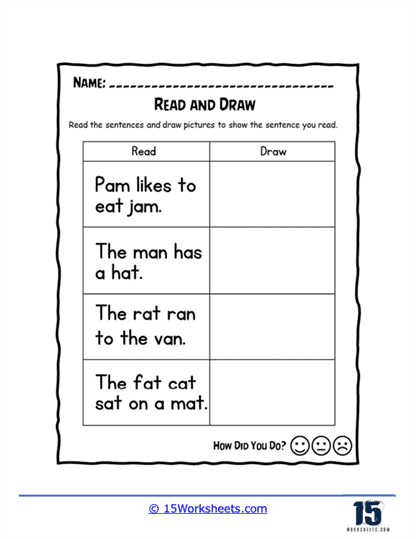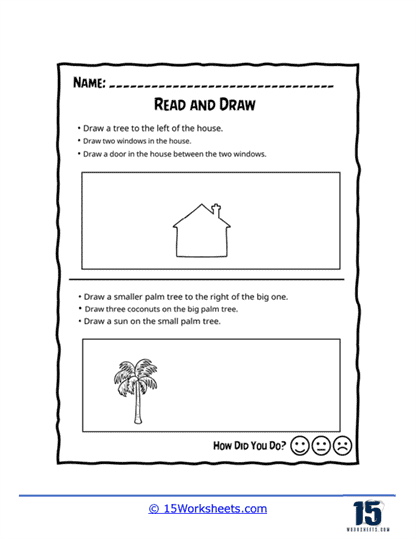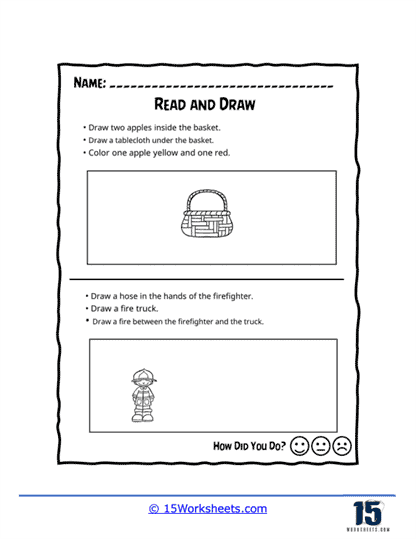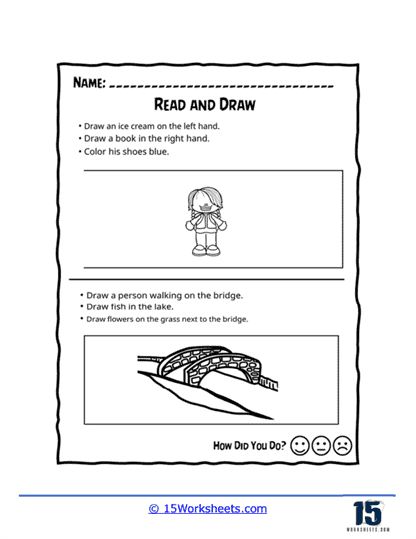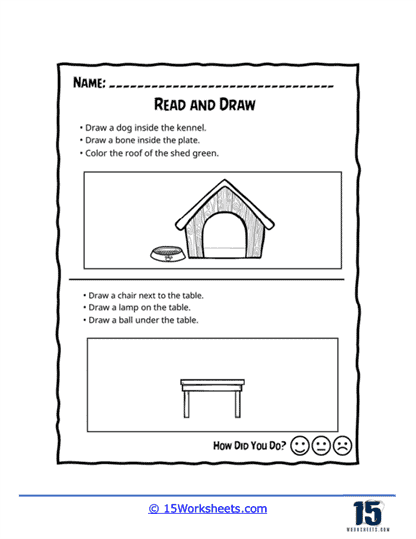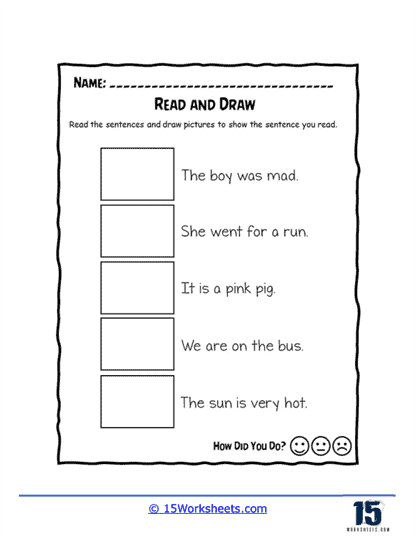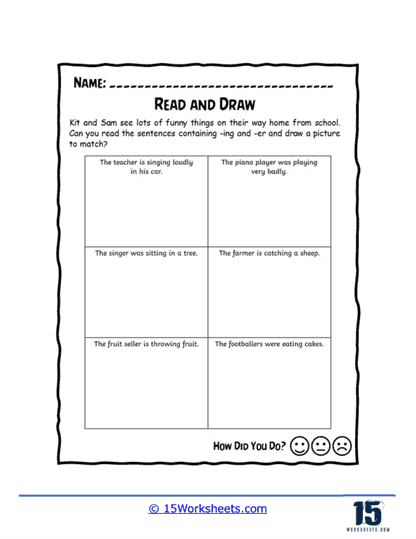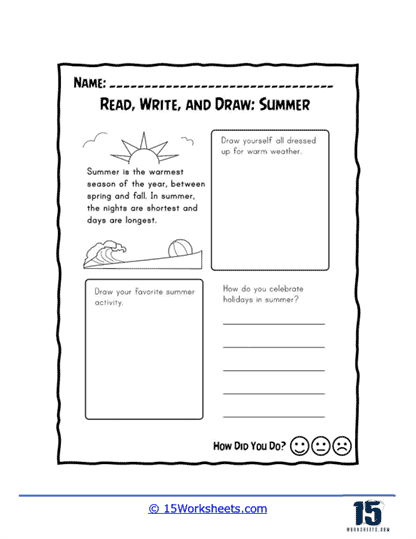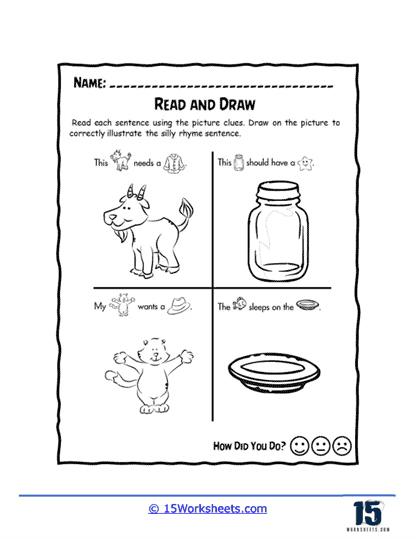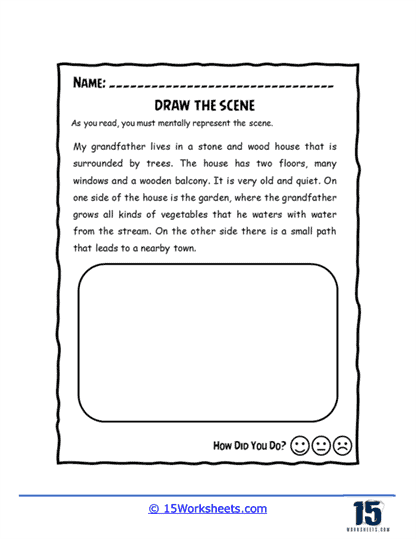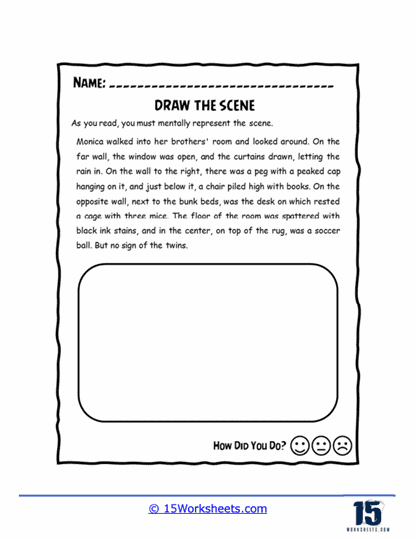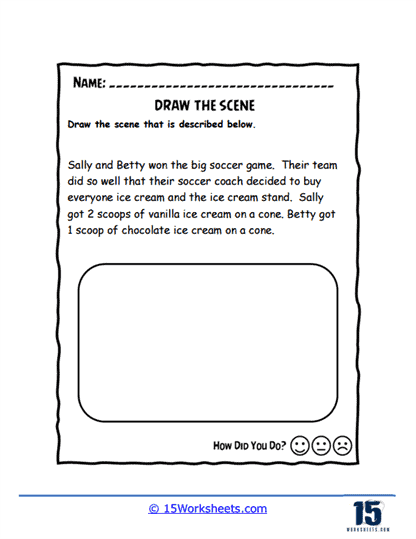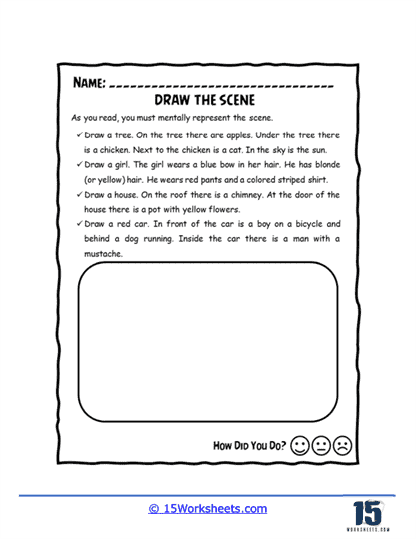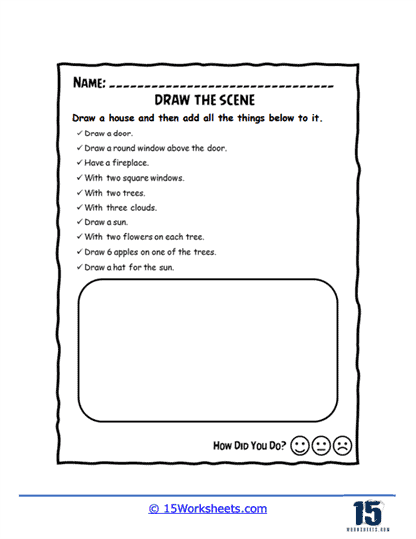Draw What You Read Worksheets
All About These 15 Worksheets
At their core, these worksheets combine two essential educational elements: reading comprehension and visual interpretation. The idea is simple but powerful-children read a passage, story, or instructions and then express their understanding by drawing. This not only allows them to think critically about the text but also encourages them to visualize what they’ve read. And here’s where the magic happens: as children create these visual representations, they reinforce their comprehension in a tangible, engaging way.
Let’s be honest-children don’t just learn by reading words on a page. They learn by interacting with ideas, images, and emotions. Draw What You Read worksheets offer a way for kids to go beyond simply decoding words. By drawing, they are invited to imagine, interpret, and engage with the material on a deeper level.
Early childhood is a golden window of opportunity for developing foundational skills. During this critical period, children’s brains are like sponges, absorbing information and creating the neural pathways that will support future learning. Literacy, of course, is at the heart of this development. But building literacy is more than teaching a child how to read-it’s about helping them understand what they’re reading, internalize it, and eventually develop a love for it.
This is where Draw What You Read Worksheets come in. They provide children with a hands-on, creative approach to reading comprehension that is far more engaging than traditional methods. Think of it as an interactive form of storytelling-one where children get to be co-creators, not just passive listeners. This level of interaction makes the process of learning to read a lot more enjoyable, and when kids enjoy what they’re doing, they’re much more likely to stick with it.
Types of Exercises
These worksheets are designed with versatility in mind, and they can be tailored to meet a variety of educational goals. Here’s a breakdown of the common elements you’ll find and the immense value they bring to the table:
1. Story Passages
Children read a story or a section of a story and are then tasked with drawing a scene, character, or setting based on their interpretation. This is a fantastic way to help children visualize narrative elements, which in turn strengthens their memory and understanding of the text. By drawing what they read, they can explore how different elements like plot, character, and setting come together to create a cohesive story.
This method is especially useful for reluctant readers. When a child knows they’ll get to draw a fun scene afterward, reading becomes a gateway to creativity, not just an academic chore. The anticipation of drawing what they’ve read helps turn reading into an enjoyable, rewarding activity.
2. Instructions or Descriptions
Here, the worksheets might provide a description of an object, scene, or situation, and the child is asked to draw based on their understanding of that description. This element encourages children to focus on details and context, sharpening their ability to extract key information from a text.
This is particularly helpful for developing critical thinking. Children must figure out which elements are most important and how to translate abstract ideas into concrete images, building their ability to interpret both literal and inferential meaning from what they read.
3. Sequencing Activities
Understanding the sequence of events in a story or process is a crucial comprehension skill. These worksheets might ask children to read a series of events and then draw them in the correct order. Not only does this improve their ability to follow instructions, but it also enhances their grasp of narrative structure and cause-and-effect relationships.
Visualizing the flow of events in a story helps solidify the progression in their minds. This makes sequencing worksheets an invaluable tool for teaching children how to organize information in a logical, linear way, which is essential not only for reading comprehension but also for writing skills down the road.
4. Visualizing Emotions or Concepts
Some worksheets focus on helping children understand abstract ideas like emotions or concepts. For example, after reading a passage about happiness, sadness, or fear, children are asked to create a visual representation of the emotions described. This type of activity helps children develop emotional intelligence by connecting feelings with visual cues. It also encourages deeper empathy, as they must think about how others feel based on textual descriptions.
In today’s world, where emotional literacy is just as important as academic literacy, this approach adds a unique dimension to traditional reading comprehension exercises. Children who can visualize and express emotions through their drawings are better equipped to navigate social interactions and manage their own feelings.
5. Compare and Contrast
In these activities, children read two different passages and then draw images that compare and contrast key elements from each. This develops their analytical skills, teaching them how to identify similarities and differences between texts. It’s also a great way to introduce more complex literacy concepts, such as themes, perspectives, and genres.
For example, a child might read two stories-one about a sunny day at the beach and another about a rainy day in the city-and then draw pictures that reflect how these environments differ in mood, setting, and activities. The act of visually contrasting these two scenarios deepens their understanding of the texts and how authors create different atmospheres through their words.
Another often overlooked benefit of these worksheets is that they provide educators and caregivers with a unique window into how a child thinks. The drawings offer valuable clues about how well the child understands the material. Did they pick up on the key themes? Are they interpreting the emotions or instructions correctly?
By examining these drawings, educators can better tailor their instruction to each individual child, addressing any gaps in comprehension and adapting their teaching methods to suit the learner’s needs. This kind of personalized attention is critical for fostering a love of reading and storytelling.
How Does Drawing What You Read Help?
Imagine a learning technique so simple, yet so powerful, that it transforms the way you absorb and understand information. A method that engages your brain in ways that traditional reading cannot, making complex ideas easier to digest, remember, and retrieve. That’s the magic of drawing what you read-a dynamic, hands-on approach that combines the benefits of visualization, creativity, and active learning into one potent tool for knowledge retention.
Bringing Words to Life
When you draw what you read, you’re not just passively skimming over text. You’re bringing the content to life through visualization. Each word you read triggers a mental image, and when you translate that image onto paper, you reinforce your understanding of the material. This active visualization creates a mental map that helps you “see” the information in a way that mere reading cannot achieve.
Visualizing what you read is like creating a mental movie where the characters, settings, and concepts are vividly alive in your imagination. And the best part? Every time you revisit that drawing, you’re reactivating those same mental images, making recall and comprehension easier and faster.
Sharpening the Mind
Let’s face it-distractions are everywhere. It’s easy to lose focus when you’re simply reading. However, drawing demands your full attention. Your brain has to simultaneously process the text and think about how to translate it visually. This dual action sharpens your focus and keeps your mind actively engaged in the task at hand. Instead of just reading the words on autopilot, you are now fully immersed in the material.
By concentrating on creating meaningful drawings, your brain absorbs the material on a deeper level. That level of engagement enhances retention and makes learning a more active, enjoyable process.
Active Learning in Action
Drawing is the epitome of active learning. Unlike passive reading, where information is absorbed at a surface level, drawing requires you to actively engage with the material. You’re not just reading words-you’re processing them, breaking them down, and reconstructing them into something tangible. This process of active engagement helps you internalize the information, making it more memorable and meaningful.
When you draw, you’re also tapping into multiple cognitive functions at once: comprehension, analysis, synthesis, and creativity. This multifaceted approach enriches your understanding of the content and creates deeper connections between concepts.
Simplifying Through Drawing
One of the most valuable aspects of drawing what you read is its ability to simplify complex information. Concepts that might seem difficult or abstract when written can be broken down into simpler, more understandable components through visual representation. Diagrams, flowcharts, and sketches allow you to see relationships between ideas that might otherwise remain hidden in dense text.
This visual breakdown not only helps you grasp the material more effectively, but it also improves your ability to explain the content to others. Whether you’re studying for an exam or teaching a concept to someone else, drawings can serve as a powerful tool for conveying ideas clearly and succinctly.
A Multi-Sensory Approach
Memory is most effectively retained when multiple senses are engaged in the learning process. By drawing what you read, you’re combining sight, touch, and even a bit of spatial awareness. This multi-sensory engagement significantly improves your ability to recall information later. The physical act of drawing helps anchor the material in your mind, creating a strong association between the visual representation and the text.
Think of it as layering your memory with multiple cues-visual, tactile, and spatial. These layers make the information stick in your brain in a way that traditional note-taking or reading alone simply cannot.
Unlocking New Perspectives
Creativity isn’t just about making beautiful pictures; it’s about thinking differently. Drawing what you read stimulates your creative mind, encouraging you to approach the material from new angles. This creative engagement can lead to breakthroughs in understanding, as you begin to notice patterns, connections, and ideas that may have eluded you during traditional study methods.
Through drawing, you may find yourself making associations that enrich your comprehension of the material. The freedom to interpret and represent ideas visually also allows you to personalize the learning process, turning the content into something uniquely yours.
Making Knowledge Your Own
Everyone learns differently. What works for one person may not work for another, and drawing offers a personalized approach to learning that caters to individual needs. When you draw what you read, you’re translating the material into something that makes sense to you. You’re creating a visual shorthand that reflects your understanding and interpretation, which makes the information far more relatable and memorable.
This level of personalization transforms passive information into an active part of your cognitive toolkit, allowing you to interact with the material in a way that suits your learning style best.
A Lifelong Skill
Whether you’re a student, a professional, or simply a curious mind, drawing what you read is a tool that can serve you well throughout your life. It empowers you to learn more effectively, remember longer, and engage with material on a deeper level. It’s not just about making pretty pictures-it’s about transforming the way you think, process, and retain information.
Incorporating this technique into your learning routine saves you time, reduces stress, and makes the act of studying not only more effective but also more enjoyable. It’s a small change with enormous benefits-why not give it a try?

